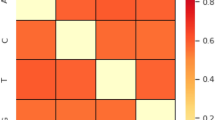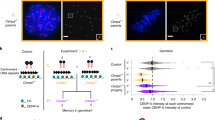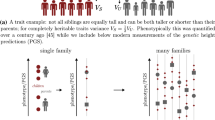Abstract
Recombination occurs in automictic parthenogens, but it is localized to the DNA between the chiasma and the telomere if central fusion (fusion of non-sister nuclei of meiosis II) occurs, and to the DNA between the chiasma and the centromere if terminal fusion (of sister nuclei of meiosis II) occurs. Independent assortment of recombined DNA leads to more variability. Here it is argued that by comparing heritabilities obtained from sib analysis of sexually-reproducing individuals with heritabilities obtained from parent-offspring regressions of automictic individuals, one can obtain an estimate of the coefficient of relationship (r) between automatically produced offspring and their parents. The coefficient of relationship for different traits will differ and can be related to the average position (in relation to chiasmata) of genes affecting the trait or to the heterozygosity of the genes.
Similar content being viewed by others
Article PDF
References
Falconer, D S. 1990. Introduction to Quantitative Genetics. Longman Group (FE), Hong Kong.
Hillesheim, E, and Moritz, R F A. 1987. Genetic variance of physiological characters in the Cape honeybee. J Apic Res, 26, 30–36.
Johansson, I, and Korkmann, N. 1950. A study of the variation in production traits of bacon pigs. Acta Agr Scand, 1, 62–78.
Malecot, G. 1948. Les Mathématiques de l'Hérédité. Masson, Paris.
Moritz, R F A, and Hillesheim, E. 1985. Inheritance of dominance in honeybees (Apis mellifera capensis Esch.). Behav Ecol Sociobiol, 17, 87–89.
Moritz, R F A, and Klepsch, A. 1985. Estimating heritabilities of worker characters: a new approach using laying workers of the Cape honeybee (Apis mellifera capensis Esch.) Apidologie, 156, 47–56.
Verma, S, and Ruttner, F. 1983. Cytological analysis of the thelytokous parthenogenesis in the Cape honeybee (Apis mellifera capensis Esch.). Apidologie, 14, 41–57.
Woyke, J. 1963. What happens to diploid drone larvae in a honeybee colony. J Apic Res, 2, 73–76.
Author information
Authors and Affiliations
Rights and permissions
About this article
Cite this article
Greeff, J., Villet, M. Deducing the coefficient of relationship by the amount of recombination produced during automictic parthenogenesis. Heredity 70, 499–502 (1993). https://doi.org/10.1038/hdy.1993.72
Received:
Issue date:
DOI: https://doi.org/10.1038/hdy.1993.72
Keywords
This article is cited by
-
The frequency of arrhenotoky in the normally thelytokous Apis mellifera capensis worker and the Clone reproductive parasite
Insectes Sociaux (2015)
-
Thelytoky in the honey bee
Apidologie (2014)
-
Lack of meiotic recombination in thelytokous parthenogenesis of laying workers of Apis mellifera capensis (the Cape honeybee)
Heredity (1994)



